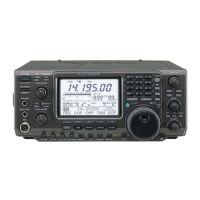Why is transmitting impossible on my Icom Transceiver?
- KKimberly DurhamSep 8, 2025
If your Icom Transceiver is unable to transmit, ensure that the operating frequency is set to a ham band.

Why is transmitting impossible on my Icom Transceiver?
If your Icom Transceiver is unable to transmit, ensure that the operating frequency is set to a ham band.
Why doesn't the programmed scan stop on my Icom IC-7400?
If the programmed scan on your Icom Transceiver doesn't stop, it might be because the squelch is open. Set [RF/SQL] to the threshold point. Alternatively, [RF/SQL] might be assigned to RF gain control, also causing the squelch to remain open. In this case, reset the [RF/SQL] control assignment and set it to the threshold point.
Why doesn't programmed scan start on my Icom Transceiver?
If the programmed scan on your Icom Transceiver does not start, it could be because the same frequencies have been programmed in scan edge memory channels P1 and P2. Program different frequencies in scan edge memory channel P1 and P2.
Why doesn't memory scan start on my Icom IC-7400?
If the memory scan on your Icom Transceiver doesn't start, it's possible that fewer than two memory channels have been programmed. Ensure that you program more than two memory channels.
Why doesn't select memory scan start on my Icom IC-7400 Transceiver?
If the select memory scan on your Icom Transceiver does not start, it's likely that fewer than two memory channels have been designated as select channels. Designate more than two memory channels as select channels for the scan.
| Frequency Range TX | 1.8-54 MHz |
|---|---|
| Frequency Range RX | 0.03-60 MHz |
| Modes | SSB, CW, RTTY, AM, FM |
| Output Power | 100W (HF/50MHz), 50W (144MHz) |
| Receiver Type | Triple conversion superheterodyne |
| Antenna Connector | SO-239 |
| IF Rejection | More than 70 dB |
| Supply Voltage | 13.8 V DC ±15% |
| Current Drain RX | 1.5 A |
| Image Rejection | More than 70 dB |
| Audio Output Power | 2 W |
| Current Drain TX | 20 A |
| Sensitivity | 0.13 μV (SSB/CW) |
| Selectivity | SSB: 2.4 kHz |
Essential safety guidelines for operating the transceiver to prevent hazards.
Steps for setting up the transceiver, including grounding and antenna connections.
Basic operational steps for using the transceiver.
Detailed description of all controls and indicators on the front of the transceiver.
Description of rear panel connectors for antennas, power, and accessories.
Explanation of the transceiver's display elements and indicators.
Guidelines for connecting the antenna system for optimal performance.
Procedure for resetting the transceiver's CPU to factory defaults.
How to select the desired operating band using the band stacking registers.
Switching between VFO and memory modes for frequency selection.
Step-by-step guide to operating the transceiver in SSB mode.
Guide for operating the transceiver in CW mode, including keying.
Selecting and adjusting IF filters for optimal signal clarity.
Enabling voice-operated transmission for hands-free operation.
Overview of memory channels for storing frequencies and modes.
Explanation of different scan modes like programmed, memory, and ∂F scan.
How to operate the internal automatic antenna tuner.
Operating packet (AFSK) communications with a TNC.
Accessing and configuring general transceiver settings.
A guide to diagnosing and resolving common operational problems.
General specifications including frequency coverage, modes, and power.
Notes on installation and safety compliance related to CE regulations.